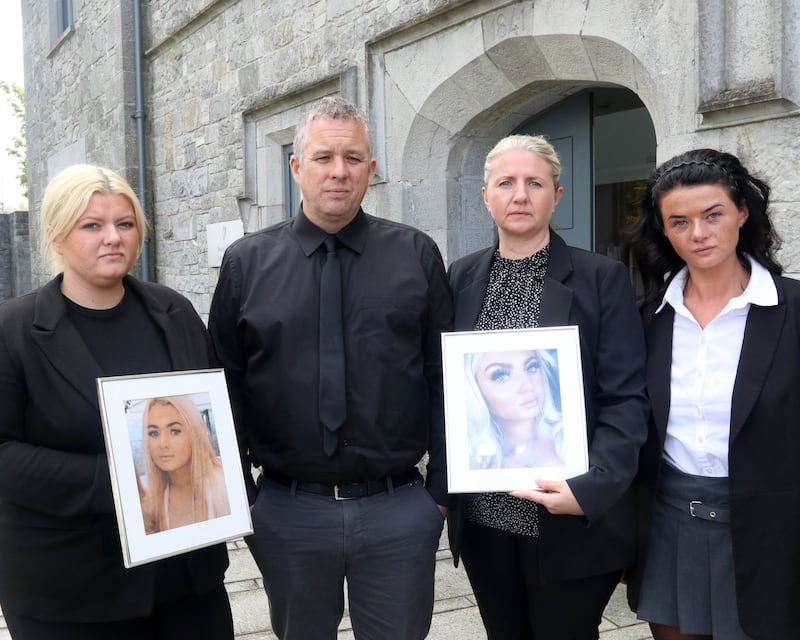Aoife Johnston spent her final hours in an emergency department that could not function – and ultimately, an emergency department that did not provide the care she desperately needed until it was too late.
Ms Johnston (16) died at University Hospital Limerick (UHL) on December 19th, 2022, from purulent meningitis. She had presented at the hospital’s emergency department two days earlier, on the evening of December 17th, suffering from a suspected case of sepsis.
Over four days of evidence at Limerick Coroner’s Court this week, again and again the same descriptors were used for the hospital’s severely overcrowded emergency department: “chaotic”; “unprecedented”; “like a war zone”. At one point, as he cross-examined a witness, Damien Tansey SC, solicitor for the bereaved Johnston family, reached for a comparison to images of devastated hospitals in Gaza.
Dr Leandri Card, a senior house officer working in the emergency department that weekend, told the inquest that the department was “not a safe environment”. At one point, the inquest heard, Dr Card was attempting to manage 191 patients in the department on her own.
READ MORE
As the patient numbers swelled, advice was conveyed by Fiona Steed, then the general nursing manager and “executive on call” that weekend, to tackle capacity issues. Much of this advice, the inquest heard, was not followed.
“I wrongly, and regrettably, presumed that my advice had been followed,” Ms Steed said.
Much of the evidence given by Dr Jim Gray – the on-call emergency medicine consultant that weekend – relating to the state of the emergency department was damning.
He likened the department to an aeroplane, with passengers in every seat and blocking up the aisles. “The department could not function.”
Patients were back-to-back on trolleys, with every conceivable space occupied. “It was a death trap,” Dr Gray said.
Amid this chaos, Aoife Johnston lay on a makeshift bed – two chairs pushed together by her desperate parents, James and Carol – dying from sepsis, brought on by meningitis. Triaged as a high-priority patient, Ms Johnston should have been seen by a doctor within 10 to 15 minutes of arriving at the emergency department.
With every hour that passed, her chances of survival dropped exponentially, the inquest heard.
Dr Card eventually saw Ms Johnston – out of turn following repeated pleas by Ms Johnston’s parents and other patients – the following morning, at 6am. Dr Card correctly identified Ms Johnston’s suffering from meningitis, and prescribed vital antibiotics.
During the inquest, both Mr Tansey and Dr Gray praised Dr Card’s efforts to help Ms Johnston.
But by that stage, it was too late for the teenager from Shannon, Co Clare.
Left untreated and in septic shock for hours, Ms Johnston’s death was inevitable, the inquest heard.
Ms Johnston died from meningitis a day later, in the hospital’s intensive care unit.
“The system failed her, the emergency department failed her,” Dr Gray told the inquest.
As he recorded a verdict of medical misadventure into her death on Thursday, coroner John McNamara said there were systemic failures, missed opportunities and communication breakdowns at UHL during the period in which Ms Johnston attended there before her death.
The conditions at UHL’s emergency department on the weekend of Ms Johnston’s death, laid bare at this week’s inquest, were not a once-off.
On the contrary, overcrowding is a chronic problem at UHL, and continues to be even now. “It’s still the most overcrowded hospital in this State today,” Dr Gray told the inquest.
He agreed with Mr Tansey that the emergency department remains, as he characterised it, “a death trap“.
“The numbers bear it out, if you look at the numbers.”

On Thursday morning, the final day of the inquest, UHL was, indeed, the most overcrowded hospital in the State. According to figures from the Irish Nurses and Midwives Organisation (INMO), 82 patients were waiting for a bed in the hospital.
On Friday morning, that figure had jumped to 106.
In the aftermath of Ms Johnston’s death, efforts were made to alleviate persistent overcrowding. Dr Damien Ryan, clinical director at UHL, told the inquest of nine recommendations made by the Hamilton report, an independent inquiry carried out following Ms Johnston’s death.
One of the key recommendations, the inquest heard, was the implementation of a “zero tolerance” approach to having patients on trolleys in the emergency department. This recommendation, at present, is not being met, Dr Gray told the inquest.
The inquest also heard how a new block of 96 beds is being built at the hospital, expected to be completed in the second quarter of 2025, according to the Health Service Executive’s counsel, Conor Halpin SC. Mr Tansey pointed out that a portion of those 96 beds will replace existing beds.
“It’s not enough,” Dr Gray said, when asked about the new block. “It’s a step in the right direction, but it’s not enough.”
“They’d need 300 beds, at least ... on top of what we have at the moment.”
A second block of 97 beds is also planned, according to Mr Halpin, but it will not be ready for several years.
Dr Gray linked the persistent overcrowding at UHL to the reconfiguration of HSE services in the midwest region in 2009, when 24-hour emergency departments in Ennis and Nenagh were closed.
As long as patients who no longer require emergency care are forced to remain in the emergency department due to a lack of beds, the department will be a dangerous environment, Dr Gray said.
On Friday, Tánasite Micheál Martin said there was a need for a review of the entire emergency response service in the midwest area.
“It is unquestionably a failure of care within the hospital and, in my view, serious action has to take place,” he said, speaking of Ms Johnston’s death. “There’s a need for fundamental reform at the hospital in respect of how things are organised.
“There is a need to respond properly to an unacceptable and devastating loss of life, all for the want of prescribing antibiotics for sepsis situations,” he said.
As Mr Tansey made his final remarks to the inquest on Thursday afternoon, reporters discreetly passed tissue packets to the visibly emotional Johnston family, sitting behind their solicitor.
Gesturing to the family, Mr Tansey stated that it was their “fervent wish” that no other family would have to endure what they did over the last year, over the last week.
Without Government action, James Johnston said outside Kilmallock Courthouse, that is not a guarantee.
“They need to get on with it, and sort it out. More people are going to die in that hospital. One million per cent. They need to sort it out.”
- Sign up for push alerts and have the best news, analysis and comment delivered directly to your phone
- Find The Irish Times on WhatsApp and stay up to date
- Listen to our Inside Politics podcast for the best political chat and analysis




















